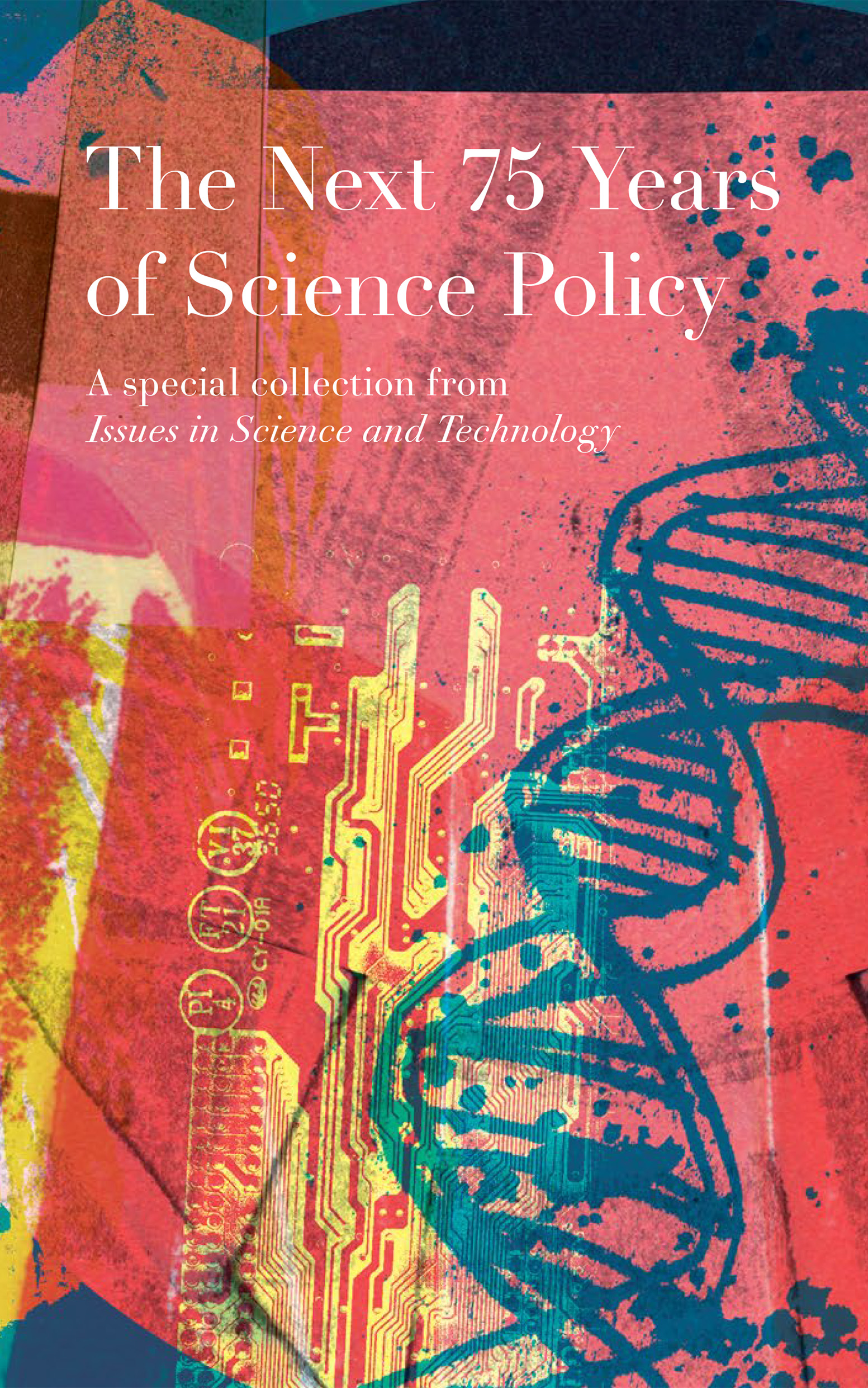Featured writers in a new book were given a major mission — to envision future science policies and share them with the world.
“The Next 75 Years of Science Policy” presents a wide range of visions for how science might serve society in the coming years. Released in September, the book showcases a collection of nearly 50 powerful essays that authors hope will provide inspiring ideas that can transform society.
“The essays presented a kind of a kaleidoscope of how to use the resources of science over the coming century,” said Lisa Margonelli, editor-in-chief for Issues in Science and Technology, which originally published the essays. “Some writers wanted to change a basically successful system by giving it a few tweaks. Others had really revolutionary ideas.”
The volume has a forward-looking theme, with everyone from scientists and government officials to up-and-coming researchers and business leaders contributing their public policy ideas for the future.
Lindy Elkins-Tanton, vice president of the Arizona State University Interplanetary Initiative, contributed the essay "Time to Say Goodbye to Our Heroes?" It makes the case for replacing the principal investigator research model with a more interdisciplinary approach.
ASU President Michael Crow penned the foreword and introduction to the book, along with Marcia McNutt, president of the National Academies of Sciences, and Cynthia Friend, president of the Kavli Foundation. The foundation supported the book’s editing and publication.
All of the essays were original published during the past two years in the journal Issues in Science and Technology, an engaging, intellectual platform where researchers, policymakers and business leaders share their ideas related to science and technology, creating a dialogue that has impacted U.S. and global public policy. The publication is a partnership between ASU and the National Academies of Sciences, Engineering and Medicine.
ASU News spoke with Margonelli about the new book.
Editor's note: The following interview has been edited for length and clarity.
Question: Where did the idea for the book come from?
Answer: In 2020, the National Academies of Sciences, Engineering and Medicine and ASU were approached by the Kavli Foundation to look back at the last 75 years of science policy and get engaged thinkers to contemplate how we should set science policy for the next 75 years.
The way we invest in science in this country all comes from a very influential report titled "Science, The Endless Frontier." It was written about 75 years ago — in 1945 — by the late Vannevar Bush, director of what was then the Office of Scientific Research and Development and sent to former President Franklin D. Roosevelt. The ideas in that memo set the pattern for how we invest in science and technology in this country. So with the book, we tried to imagine how the next 75 years could look.
Q: How were contributors to the book selected?
A: Some are people who've been big players in science policy for a really long time — people like Norman R. Augustine and Neal Lane, who have put out highly influential white papers and really changed the focus of policy and competitiveness over the years — as well as leaders at the National Science Board such as astronaut Ellen Ochoa. And some thinkers who were influential scientists but hadn’t written much about science policy before — like ASU’s Lindy Elkins Tanton.
And then, some of the contributors are up-and-coming people with fresh ideas. We were looking for a diversity of thoughts and perspectives. We tried to build a really big tent to have the biggest possible discussion about what kind of future we want and how we might get there.
Q: What were some of the urgent or important issues that the book brought to light?
A: There is a really insightful piece called "Stuck in 1955, Engineering Education Needs a Revolution" by Sheryl Sorby, Norman L. Fortenberry and Gary Bertoline. They questioned the way engineers are educated, which is still based on a template developed in 1955 — a philosophy of winnowing out students through certain foundational classes. And so, the people who become engineers have to make it through that particular maze.
What that means is that you only have a certain kind of problem-solver and you won't have a diverse crowd there — and they may not be able to solve some of today’s complex socio-technical problems. That article generated a lot of conversation and led to a virtual conversation with hundreds of participants.
And then we had an inspiring piece, "Creating a New Moral Imagination for Engineering," from ASU’s Darshan Karwat, a young scholar at ASU’s School for the Future of Innovation in Society, who wants engineering to develop a sense of moral imagination, which is really important for connecting the discipline with younger scientists and people who are interested in changing the world
Q: The essays in the book come from the publication Issues in Science and Technology. How and why was Issues created?
A: Issues was created by the National Academies of Sciences, Engineering and Medicine in 1984. It was started as a way of bringing new perspectives and conversations to democratic decision-making. ASU became a full partner in the magazine in 2013.
The difference between us and an academic journal is pretty straightforward — academic journals really speak from one academic to another. They are a closed discussion within experts. We are having a wider, broader discussion. We bring lots and lots of different people to the discussion. We try to make our discussions interdisciplinary and very accessible. We also invite decision makers and business people into the conversation.
And we're not peer reviewed. This is a journal of opinion and we work with every author to make their argument as strong as possible.
We are not like other technology magazines, which are likely to have articles like "Six Technologies that are Going to Change the World." Instead we have something like seven big questions we should ask about virtual reality. Tech magazines tend to see technology as an inevitable force, whereas we see it as something that is continually shaped by policies and human values.
And one of the things that's really key to our vision, which animates me and the whole incredible Issues team, is that we really believe that policies for science and technology need to be designed for the betterment of society.
Q: The book is forward-looking. How do you hope it will direct the course of science and technology related policies over the next 75 years?
A: My big hope is that we stop talking about science and technology policies purely in the sense of where the money goes and start talking about the world we intend to create. We know that we can really help young scientists by supporting them better and we can work with interdisciplinary teams to solve big problems, so we can build on some of the policies that were incredibly successful over the last 75 years and adopt new methods for even greater success in the future.
And finally, we hope to inspire more conversation and vision about how to use the tools of science and technology to really create better lives for more people.
Top photo courtesy iStock
More Science and technology

ASU-led Southwest Advanced Prototyping Hub awarded $21.3M for 2nd year of funding for microelectronics projects
The Southwest Advanced Prototyping (SWAP) Hub, led by Arizona State University, has been awarded $21.3 million in Year 2 funding under the CHIPS and Science Act to continue its work advancing the…

Celebrating '20 Years of Discovery' at the Biodesign Institute
Editor’s note: The Biodesign Institute at Arizona State University wraps up its 20th anniversary with the sixth and final installment of its "20 Years of Discovery" series. Each story highlights…

Student research supports semiconductor sustainability
As microelectronics have become an increasingly essential part of modern society, greenhouse gas emissions, which are associated with their use and manufacture, have increased in tandem.…

